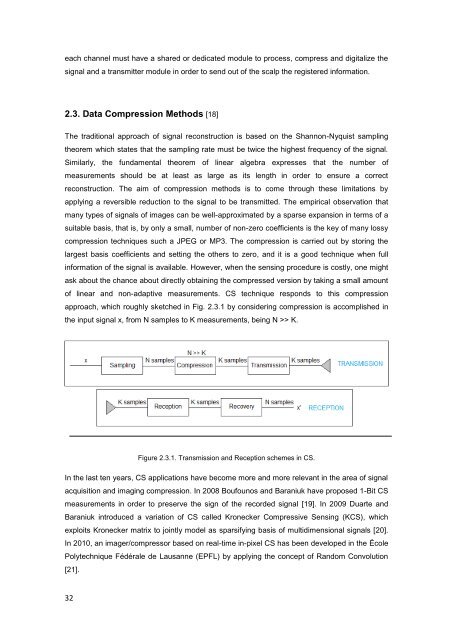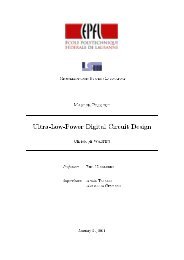Compressive Sensing system for recording of ECoG signals in-vivo
Compressive Sensing system for recording of ECoG signals in-vivo
Compressive Sensing system for recording of ECoG signals in-vivo
You also want an ePaper? Increase the reach of your titles
YUMPU automatically turns print PDFs into web optimized ePapers that Google loves.
each channel must have a shared or dedicated module to process, compress and digitalize thesignal and a transmitter module <strong>in</strong> order to send out <strong>of</strong> the scalp the registered <strong>in</strong><strong>for</strong>mation.2.3. Data Compression Methods [18]The traditional approach <strong>of</strong> signal reconstruction is based on the Shannon-Nyquist sampl<strong>in</strong>gtheorem which states that the sampl<strong>in</strong>g rate must be twice the highest frequency <strong>of</strong> the signal.Similarly, the fundamental theorem <strong>of</strong> l<strong>in</strong>ear algebra expresses that the number <strong>of</strong>measurements should be at least as large as its length <strong>in</strong> order to ensure a correctreconstruction. The aim <strong>of</strong> compression methods is to come through these limitations byapply<strong>in</strong>g a reversible reduction to the signal to be transmitted. The empirical observation thatmany types <strong>of</strong> <strong>signals</strong> <strong>of</strong> images can be well-approximated by a sparse expansion <strong>in</strong> terms <strong>of</strong> asuitable basis, that is, by only a small, number <strong>of</strong> non-zero coefficients is the key <strong>of</strong> many lossycompression techniques such a JPEG or MP3. The compression is carried out by stor<strong>in</strong>g thelargest basis coefficients and sett<strong>in</strong>g the others to zero, and it is a good technique when full<strong>in</strong><strong>for</strong>mation <strong>of</strong> the signal is available. However, when the sens<strong>in</strong>g procedure is costly, one mightask about the chance about directly obta<strong>in</strong><strong>in</strong>g the compressed version by tak<strong>in</strong>g a small amount<strong>of</strong> l<strong>in</strong>ear and non-adaptive measurements. CS technique responds to this compressionapproach, which roughly sketched <strong>in</strong> Fig. 2.3.1 by consider<strong>in</strong>g compression is accomplished <strong>in</strong>the <strong>in</strong>put signal x, from N samples to K measurements, be<strong>in</strong>g N >> K.Figure 2.3.1. Transmission and Reception schemes <strong>in</strong> CS.In the last ten years, CS applications have become more and more relevant <strong>in</strong> the area <strong>of</strong> signalacquisition and imag<strong>in</strong>g compression. In 2008 Boufounos and Baraniuk have proposed 1-Bit CSmeasurements <strong>in</strong> order to preserve the sign <strong>of</strong> the recorded signal [19]. In 2009 Duarte andBaraniuk <strong>in</strong>troduced a variation <strong>of</strong> CS called Kronecker <strong>Compressive</strong> <strong>Sens<strong>in</strong>g</strong> (KCS), whichexploits Kronecker matrix to jo<strong>in</strong>tly model as sparsify<strong>in</strong>g basis <strong>of</strong> multidimensional <strong>signals</strong> [20].In 2010, an imager/compressor based on real-time <strong>in</strong>-pixel CS has been developed <strong>in</strong> the ÉcolePolytechnique Fédérale de Lausanne (EPFL) by apply<strong>in</strong>g the concept <strong>of</strong> Random Convolution[21].32















